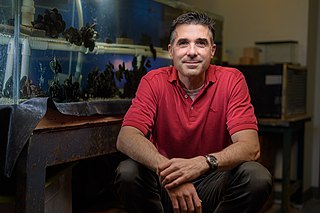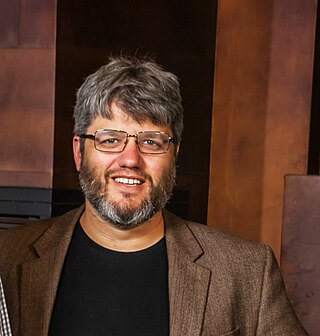Related Research Articles

Rhenium is a chemical element; it has symbol Re and atomic number 75. It is a silvery-gray, heavy, third-row transition metal in group 7 of the periodic table. With an estimated average concentration of 1 part per billion (ppb), rhenium is one of the rarest elements in the Earth's crust. It has the third-highest melting point and second-highest boiling point of any element at 5869 K. It resembles manganese and technetium chemically and is mainly obtained as a by-product of the extraction and refinement of molybdenum and copper ores. It shows in its compounds a wide variety of oxidation states ranging from −1 to +7.

Tetrahydrofuran (THF), or oxolane, is an organic compound with the formula (CH2)4O. The compound is classified as heterocyclic compound, specifically a cyclic ether. It is a colorless, water-miscible organic liquid with low viscosity. It is mainly used as a precursor to polymers. Being polar and having a wide liquid range, THF is a versatile solvent.

In organic chemistry, thioesters are organosulfur compounds with the molecular structure R−C(=O)−S−R’. They are analogous to carboxylate esters with the sulfur in the thioester replacing oxygen in the carboxylate ester, as implied by the thio- prefix. They are the product of esterification of a carboxylic acid with a thiol. In biochemistry, the best-known thioesters are derivatives of coenzyme A, e.g., acetyl-CoA. The R and R' represent organyl groups, or H in the case of R.

Group 7, numbered by IUPAC nomenclature, is a group of elements in the periodic table. It contains manganese (Mn), technetium (Tc), rhenium (Re) and bohrium (Bh). This group lies in the d-block of the periodic table, and are hence transition metals. This group is sometimes called the manganese group or manganese family after its lightest member; however, the group itself has not acquired a trivial name because it belongs to the broader grouping of the transition metals.
Humins are carbon-based macromolecular substances, that can be found in soil chemistry or as a by-product from saccharide-based biorefinery processes.

A biorefinery is a refinery that converts biomass to energy and other beneficial byproducts. The International Energy Agency Bioenergy Task 42 defined biorefining as "the sustainable processing of biomass into a spectrum of bio-based products and bioenergy ". As refineries, biorefineries can provide multiple chemicals by fractioning an initial raw material (biomass) into multiple intermediates that can be further converted into value-added products. Each refining phase is also referred to as a "cascading phase". The use of biomass as feedstock can provide a benefit by reducing the impacts on the environment, as lower pollutants emissions and reduction in the emissions of hazard products. In addition, biorefineries are intended to achieve the following goals:
- Supply the current fuels and chemical building blocks
- Supply new building blocks for the production of novel materials with disruptive characteristics
- Creation of new jobs, including rural areas
- Valorization of waste
- Achieve the ultimate goal of reducing GHG emissions

Lignocellulose refers to plant dry matter (biomass), so called lignocellulosic biomass. It is the most abundantly available raw material on the Earth for the production of biofuels. It is composed of two kinds of carbohydrate polymers, cellulose and hemicellulose, and an aromatic-rich polymer called lignin. Any biomass rich in cellulose, hemicelluloses, and lignin are commonly referred to as lignocellulosic biomass. Each component has a distinct chemical behavior. Being a composite of three very different components makes the processing of lignocellulose challenging. The evolved resistance to degradation or even separation is referred to as recalcitrance. Overcoming this recalcitrance to produce useful, high value products requires a combination of heat, chemicals, enzymes, and microorganisms. These carbohydrate-containing polymers contain different sugar monomers and they are covalently bound to lignin.
Myron Lee Bender (1924–1988) was born in St. Louis, Missouri. He obtained his B.S. (1944) and his Ph.D. (1948) from Purdue University. The latter was under the direction of Henry B. Hass. After postdoctoral research under Paul D. Barlett, and Frank H. Westheimer, he spent one year as a faculty member at the University of Connecticut. Thereafter, he was a professor of Chemistry at Illinois Institute of Technology in 1951, and then at Northwestern University in 1960. He worked primarily in the study of reaction mechanisms and the biochemistry of enzyme action. Myron L. Bender demonstrated the two-step mechanism of catalysis for serine proteases, nucleophilic catalysis in ester hydrolysis and intramolecular catalysis in water. He also showed that cyclodextrin can be used to investigate catalysis of organic reactions within the scope of host–guest chemistry. Finally, he and others reported on the synthesis of an organic compound as a model of an acylchymotrypsin intermediate.
Organorhenium chemistry describes the compounds with Re−C bonds. Because rhenium is a rare element, relatively few applications exist, but the area has been a rich source of concepts and a few useful catalysts.
A transition metal oxo complex is a coordination complex containing an oxo ligand. Formally O2-, an oxo ligand can be bound to one or more metal centers, i.e. it can exist as a terminal or (most commonly) as bridging ligands (Fig. 1). Oxo ligands stabilize high oxidation states of a metal. They are also found in several metalloproteins, for example in molybdenum cofactors and in many iron-containing enzymes. One of the earliest synthetic compounds to incorporate an oxo ligand is potassium ferrate (K2FeO4), which was likely prepared by Georg E. Stahl in 1702.
Hydrothermal liquefaction (HTL) is a thermal depolymerization process used to convert wet biomass, and other macromolecules, into crude-like oil under moderate temperature and high pressure. The crude-like oil has high energy density with a lower heating value of 33.8-36.9 MJ/kg and 5-20 wt% oxygen and renewable chemicals. The process has also been called hydrous pyrolysis.

Rakesh Agrawal is a chemical engineer known for contributions to separations, cryogenic gas separation and liquefaction, and for contributions to renewable energy including the conversion of biomass to chemicals and fuels, inorganic solar cell fabrication, and the synergistic use of solar energy. He is the Winthrop E. Stone Distinguished Professor of Chemical Engineering at Purdue University in West Lafayette, Indiana.

Jonathan Wilker is an American scientist, engineer, and educator who focuses on developing marine animal-inspired underwater adhesives for use in surgery, construction, and other applications. His work has been profiled by The New York Times, National Public Radio, Popular Science, and his research findings appear in many scientific journals, such as Nature, Journal of the American Chemical Society, and ACS Applied Materials & Interfaces. He is a professor at Purdue University in West Lafayette, Indiana, where he teaches courses in inorganic chemistry and bioinorganic chemistry. Wilker has received a number of awards for his teaching including The College of Science Outstanding Teacher Award at Purdue University (2011). In addition to being in the Department of Chemistry, he is also a Professor of Materials Engineering at Purdue University. Outside activities include advocacy for federal funding of science research and development.

Abhik Ghosh is an Indian inorganic chemist and materials scientist and a professor of chemistry at UiT – The Arctic University of Norway in Tromsø, Norway.
R. Tom Baker is an inorganic chemist known for the development and application of inorganic transition metal-based catalysis.
Deoxydehydration (DODH) is a chemical reaction for removing two adjacent hydroxyl groups in a vicinal diol to form an alkene. In contrast to hydrodeoxygenation which uses hydrogen as a reductant, deoxydehydration is able to use a variety of other reductants such as alcohols and organic phosphines. In research, the most common homogeneous catalysts for this reaction use rhenium.

Paul Dauenhauer, a chemical engineer and MacArthur Fellow, is the Lanny & Charlotte Schmidt Professor at the University of Minnesota (UMN). He is recognized for his research in catalysis science and engineering, especially, his contributions to the understanding of the catalytic breakdown of cellulose to renewable chemicals, the invention of oleo-furan surfactants, and the development of catalytic resonance theory and programmable catalysts.
Jonas C. Peters is the Bren Professor of Chemistry at the California Institute of Technology and Director of the Resnick Sustainability Institute. He has contributed to the development of catalysts and photocatalysts relevant to small molecule activation.
Hilkka Inkeri Kenttämaa is a researcher in organic and bioorganic mass spectrometry, and the Frank Brown Endowed Distinguished Professor of Chemistry at Purdue University. She is a pioneer in distonic radical cation research and laser-induced acoustic desorption.
Rhenium compounds are compounds formed by the transition metal rhenium (Re). Rhenium can form in many oxidation states, and compounds are known for every oxidation state from -3 to +7 except -2, although the oxidation states +7, +4, and +3 are the most common. Rhenium is most available commercially as salts of perrhenate, including sodium and ammonium perrhenates. These are white, water-soluble compounds. The tetrathioperrhenate anion [ReS4]− is possible.
References
- ↑ "Mahdi Abu-Omar". ucsb.edu. Retrieved March 2, 2017.
- ↑ "The Mellichamp Endowed Chairs in Sustainability | Duncan and Suzanne Mellichamp Academic Initiative in Sustainability". sustech.ucsb.edu. Retrieved 2017-08-07.
- ↑ "Convocation recognizes faculty for awards, honors, teaching excellence, years of service - Purdue University". www.purdue.edu. Retrieved 2017-08-07.
- ↑ "Mellichamp Chair in Green Chemistry Appointed | Duncan and Suzanne Mellichamp Academic Initiative in Sustainability". sustech.ucsb.edu. Retrieved 2017-08-07.
- ↑ "Mahdi Abu-Omar" . Retrieved March 2, 2017.
- ↑ McPherson, Lee D.; Drees, Markus; Khan, Saeed I.; Strassner, Thomas; Abu-Omar, Mahdi M. (2004-06-01). "Multielectron Atom Transfer Reactions of Perchlorate and Other Substrates Catalyzed by Rhenium Oxazoline and Thiazoline Complexes: Reaction Kinetics, Mechanisms, and Density Functional Theory Calculations". Inorganic Chemistry. 43 (13): 4036–4050. doi:10.1021/ic0498945. ISSN 0020-1669. PMID 15206886.
- ↑ Parsell, Trenton; Yohe, Sara; Degenstein, John; Jarrell, Tiffany; Klein, Ian; Gencer, Emre; Hewetson, Barron; Hurt, Matt; Kim, Jeong Im (2015-03-10). "A synergistic biorefinery based on catalytic conversion of lignin prior to cellulose starting from lignocellulosic biomass". Green Chemistry. 17 (3): 1492–1499. doi:10.1039/C4GC01911C. ISSN 1463-9270. OSTI 1210426.
- ↑ Parsell, Trenton H.; Owen, Benjamin C.; Klein, Ian; Jarrell, Tiffany M.; Marcum, Christopher L.; Haupert, Laura J.; Amundson, Lucas M.; Kenttämaa, Hilkka I.; Ribeiro, Fabio (2013-01-02). "Cleavage and hydrodeoxygenation (HDO) of C–O bonds relevant to lignin conversion using Pd/Zn synergistic catalysis". Chemical Science. 4 (2): 806–813. doi:10.1039/C2SC21657D. ISSN 2041-6539.
- ↑ Luo, Hao; Klein, Ian M.; Jiang, Yuan; Zhu, Hanyu; Liu, Baoyuan; Kenttämaa, Hilkka I.; Abu-Omar, Mahdi M. (2016-04-04). "Total Utilization of Miscanthus Biomass, Lignin and Carbohydrates, Using Earth Abundant Nickel Catalyst". ACS Sustainable Chemistry & Engineering. 4 (4): 2316–2322. doi: 10.1021/acssuschemeng.5b01776 .
- ↑ Ziegler, Jeanette E.; Zdilla, Michael J.; Evans, Andrew J.; Abu-Omar, Mahdi M. (2009-11-02). "H2-Driven Deoxygenation of Epoxides and Diols to Alkenes Catalyzed by Methyltrioxorhenium". Inorganic Chemistry. 48 (21): 9998–10000. doi:10.1021/ic901792b. ISSN 0020-1669. PMID 19807132.
- ↑ Yi, Jing; Liu, Shuo; Abu-Omar, Mahdi M. (2012-08-01). "Rhenium-Catalyzed Transfer Hydrogenation and Deoxygenation of Biomass-Derived Polyols to Small and Useful Organics". ChemSusChem. 5 (8): 1401–1404. doi:10.1002/cssc.201200138. ISSN 1864-564X. PMID 22692826.
- ↑ Hicks, Scott D.; Petersen, Jennifer L.; Bougher, Curt J.; Abu-Omar, Mahdi M. (2011-01-17). "Chlorite Dismutation to Chlorine Dioxide Catalyzed by a Water-Soluble Manganese Porphyrin". Angewandte Chemie International Edition. 50 (3): 699–702. doi:10.1002/anie.201005128. ISSN 1521-3773. PMID 21226157.
- ↑ Novstrup, Krista A.; Travia, Nicholas E.; Medvedev, Grigori A.; Stanciu, Corneliu; Switzer, Jeffrey M.; Thomson, Kendall T.; Delgass, W. Nicholas; Abu-Omar, Mahdi M.; Caruthers, James M. (2010-01-20). "Mechanistic Detail Revealed via Comprehensive Kinetic Modeling of [rac-C2H4(1-indenyl)2ZrMe2]-Catalyzed 1-Hexene Polymerization". Journal of the American Chemical Society. 132 (2): 558–566. doi:10.1021/ja906332r. ISSN 0002-7863. PMID 20030387.
- ↑ webdesign, MaryHiggins. "Abu-Omar, Mahdi". www.beckman-foundation.org. Retrieved 2017-08-07.
- ↑ "ICPP".
- ↑ "Elected Fellows". aaas.org. Retrieved March 2, 2017.
- ↑ "Crano Memorial Lecture". www.akronacs.org. Retrieved 2017-08-07.